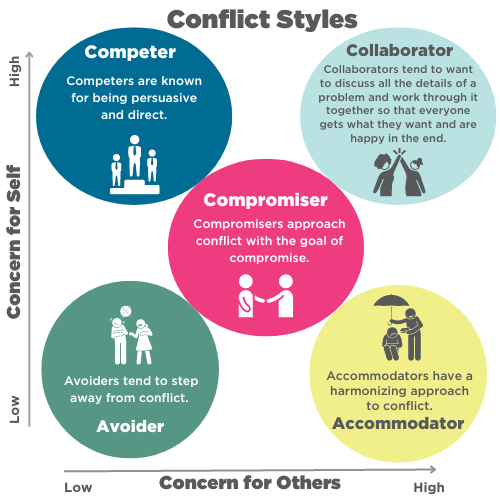Student Conduct & Community Standards (SCCS) recognizes that conflict is a necessary and normal part of life. At the University of Tennessee Knoxville, students are apart of a large community with differing values, opinions, beliefs, and behaviors.
While diverse perspectives can lead to disagreements, conflict can be a healthy part of the learning experience when approached appropriately and respectfully.
Though conflict is uncomfortable and holds a negative connotation, it can be a growth opportunity for involved parties to learn from one another.
Things to Consider…
The University of Colorado Boulder has built out a list of things to keep in mind when encountering conflict to lead to a healthy and productive experience:
- In a conversation, allow the other person to share their point of view without interrupting.
- Listen as the other person shares their point of view, instead of forming your response to what they are saying in your head.
- What you mean to say is not always what the other person hears—think about the intent and impact of your message.
- When sharing your point of view, speak from your perspective. Try to see things from the other side rather than make assumptions.
- When agreement is not possible, allow for multiple truths.
Please visit The University of Colorado Boulder’s website for more information on conflict resolution by clicking here.
Conflict Styles
Understanding that individuals tend to gravitate towards certain conflict styles can also be helpful in understanding others and navigating conflict. SCCS offers a Conflict Styles Assessment link through the United States Institute of Peace to help students understand their own conflict style. Please see the Conflict Resolution Resource page for more information about the Conflict Styles Assessment.
Below are the different conflict styles on the assessment:
 Accommodators have a harmonizing approach to conflict. They often focus on supporting others in a conflict situation and are adept at placating people in uncomfortable situations. Accommodators often gain strong appreciation from others involved in a conflict.
Accommodators have a harmonizing approach to conflict. They often focus on supporting others in a conflict situation and are adept at placating people in uncomfortable situations. Accommodators often gain strong appreciation from others involved in a conflict.
Weaknesses: Accommodators may build up resentment from denying their own needs. It also may be difficult for those who want to get to the root of the problem to work with Accommodators who tend to focus on making others happy.
In resolving conflict, Accommodators tend to have a low concern for oneself and a high concern for others, as illustrated in the graph at the bottom of the webpage.

Avoiders tend to step away from conflict. They often keep their opinions to themselves in conflict situations so as not to continue or escalate the conflict. They are often admired for having a calming, quiet presence in the face of crisis.
Weaknesses: Avoiders sometimes keep their feelings bottled up and then aren’t able to meet their own needs. This can result in a frustrating buildup of emotions.
Avoiders tend to show a low concern for oneself and a low concern for others in resolving conflict. This can be see in the graph at the bottom of the webpage.
Competers are known for being persuasive and direct. They know the result they want in a conflict situation, and they go for it. Their strengths are that they are often passionate about their views and dedicated to pursuing their convictions. Competers are good at making quick decisions, and tend not to waste time, which is especially helpful in the time of crisis.
Weaknesses: Sometimes Competers wind up with unequal relationships with others, and feelings of others can be hurt or overlooked with their decision-making style.
Competers tend to have a high concern for oneself and a low concern for others in conflict resolution. This can be seen in the graph at the bottom of the webpage.
 Compromisers approach conflict with the goal of compromise. They tend to think about what they are willing to give up and what they are willing to hold on to, and try to gear communication to focus on this give and take for all parties. It is a good way to promote cooperation. It can be done fairly quickly when both parties are engaged.
Compromisers approach conflict with the goal of compromise. They tend to think about what they are willing to give up and what they are willing to hold on to, and try to gear communication to focus on this give and take for all parties. It is a good way to promote cooperation. It can be done fairly quickly when both parties are engaged.
Compromisers tend to have an equal amount of concern for others and oneself in resolving conflict. The healthy amount of concern places Compromisers at the middle of the graph seen at the bottom of the webpage.
Collaborators and problem solvers tend to want to discuss all the details of a problem and work through it together so that everyone gets what he or she wants and is happy in the end. Their strengths are that they tend to welcome differences, build high-levels of trust and mutual understanding in relationships. There is also the potential to learn from creative collaboration.
Weaknesses: When time is a factor, it is difficult to spend the energy and time needed to process the way Collaborators tend do. There is also the potential for burnout from over-processing.
Collaborators have a high concern for oneself and a high concern for others in resolving conflict, as illustrated on the graph at the bottom of the webpage.
To further understand the different kinds of conflict styles, the graph below illustrates how these conflict styles compare to one another in terms of concern for others and concern for oneself.
A more detailed explanation about each conflict style and where each one falls on the graph can be found in the drop down menus above.



